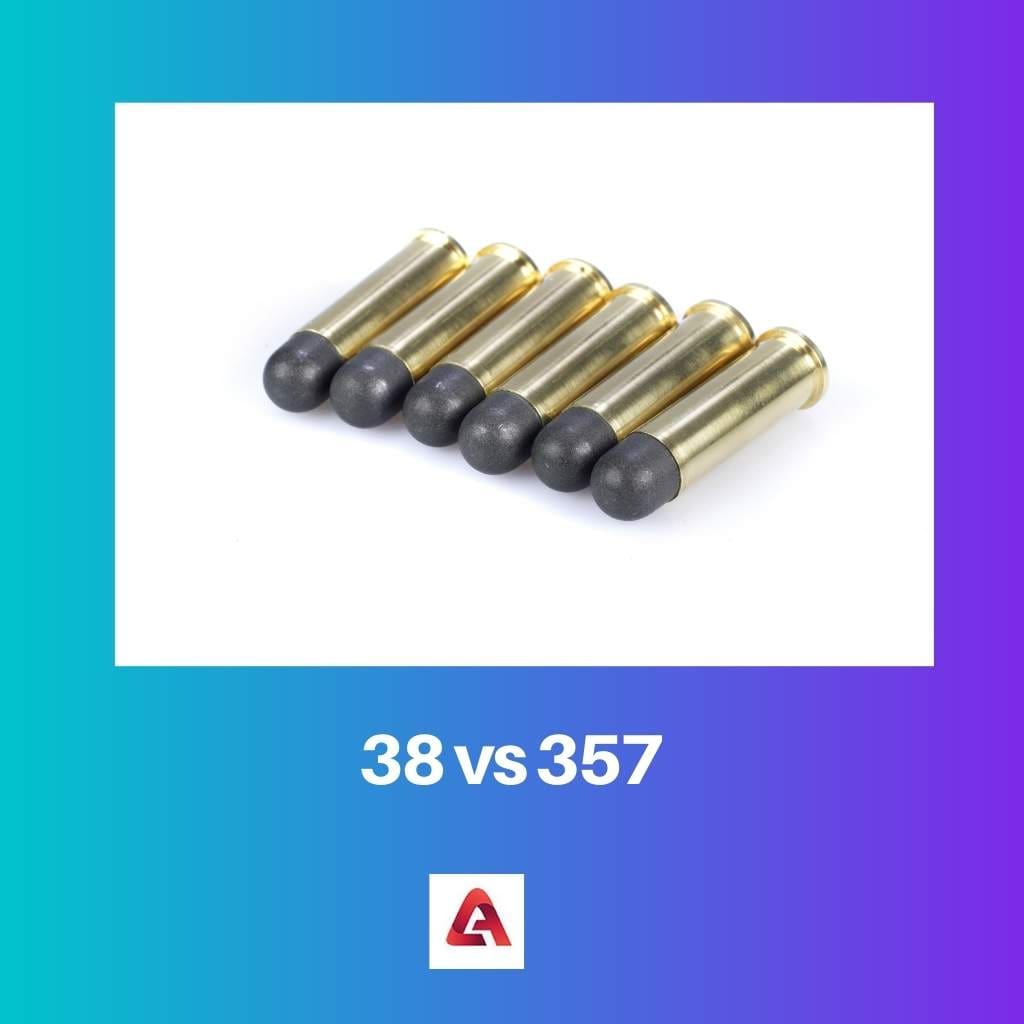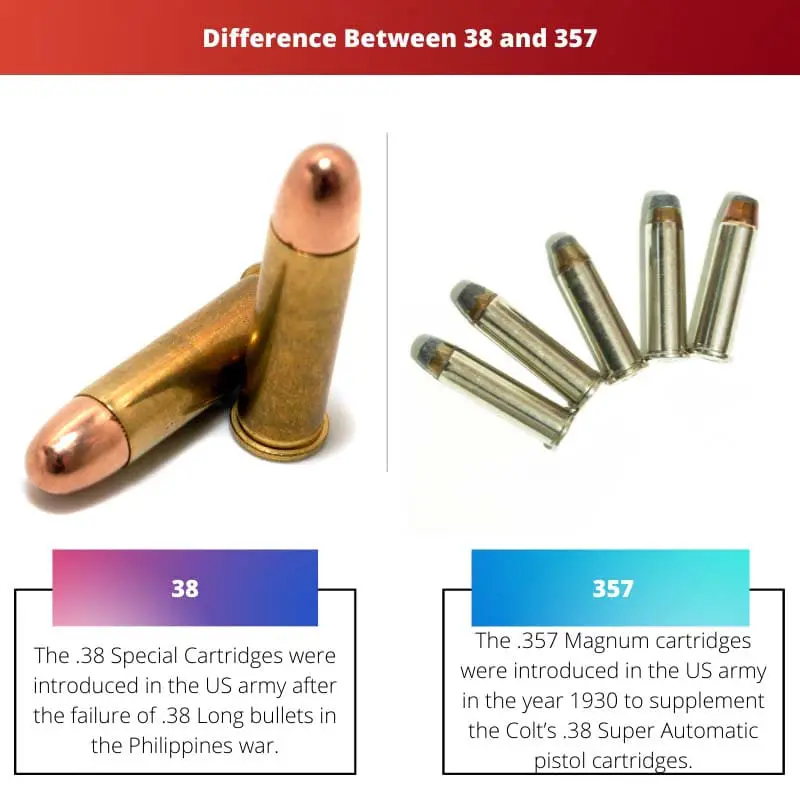We all live in a world where the risk of war always prevails. This is the reason why various nations have a set of arms and ammunition to protect themselves. The .38 Special and .357 Magnum are two types of cartridges that are used in revolvers.
Key Takeaways
- .357 is more powerful than .38 regarding muzzle velocity, energy, and stopping power.
- .38 and .357 have different cartridge lengths and can’tcan’t be used interchangeably.
- .357 is a more expensive cartridge compared to .38.
38 vs 357
Revolvers chambered for the 357 cartridges can shoot 38 rounds. 357 was designed in 1898. It has a lower maximum pressure of 17,000 PSI. While 38 was designed in 1934. It’s rim diameter and case length are slightly larger. It has a significantly higher maximum pressure of 34,000 PSI.

The .38 cartridges were introduced in the US military in the year 1898 after replacing the .38 long colt that did not possess a good stopping capacity. These are among the few cartridges that were used by the US Army in the second world war and by the US police from 1920 to 1990.
The .357 cartridges were introduced in the year 1938. It is basically used in hunting small animals like deer. It is also used in various shooting games. It was developed and designed by Elmer Keith, and Phillip B Sharpe. It has a maximum pressure of 35,000 PSI.
Comparison Table
| Parameters of Comparison | 38 | 357 |
|---|---|---|
| Designers | The designers of the .38 cartridge are Smith and Wesson of the United States of America. | The designers of the .357 cartridge are Elmer Keith, Phillip B sharp of the United States. |
| Uses | The .38 bullets were used by the US police force and army and even during the Second World War. | The .357 bullets are basically used for hunting small and medium animals and also in shooting games. |
| Maximum Pressure | The maximum pressure of .38 bullets is 17000 PSI. | The maximum pressure of .357 cartridges is 35000 PSI. |
| Muzzle velocity | The muzzle velocity of the .38 bullets is comparatively less, which is 940 ft/s. | The muzzle velocity of the .357 cartridges is comparatively more, which is 1090 ft/s. |
| Equipment | The .38 cartridges are used in semi-automatic pistols and carbines. | The .357 cartridges are used in pistols and rifles for hunting. |
| Stopping Power | The stopping power of .38 cartridges is not as good as the .357 cartridges. | The .357 cartridges are used in self-defense due to their efficient stopping power. |
What is 38?
The .38 Special Cartridges were introduced in the US army after the failure of .38 Long bullets in the Philippines war. It was introduced due to its higher muzzle velocity and pressure.
It has an immense amount of power and speed that helped it be among the few cartridges that were used by the US Army and police from the year 1930 to 1990.
It is one of the famous cartridges that are used for self-defence and target shooting. Generally, the .38 bullets are much cheaper when compared to the .357 cartridges.
A basic .38 cartridge brings a muzzle velocity of 755 ft/s, which is far less when compared to the muzzle velocity of .357 cartridges.
The major merits of the .38 Special Cartridges are:-
- One of the major advantages of the .38 cartridges is that it has cheap ammo.
- It has a lower recoil rate.
- It has very cheap firearms.
The major demerits of the .38 Special Cartridges are:-
- One of the major disadvantages of the .38 cartridges is their inefficient stopping power and capacity, making them less defensive.
- The .38 cartridges have limited application and use in the present world.

What is 357?
The .357 Magnum cartridges were introduced in the US Army in the year 1930 to supplement Colt’s .38 Super Automatic pistol cartridges. The cartridge chamber volume is about 1.66 milliliters. It is one of the best cartridges that are used for hunting small and medium-sized animals.
It has a very strong defence and effective holding power. It can also be used against large animals by proper loading. Due to its defensive traits, it is used by security guards outside the ATMs, by civilians for hunting and self-defence, and also by police during highway patrolling.
The major merits of the .357 Magnum cartridges are:-
- One of the major advantages of the .357 Magnum cartridge is that it has more diverse uses and applications.
- It has a higher muzzle velocity and thus has good penetrating power and stopping power.
- Another advantage is that firearms can also use.38 Special Cartridges.
The major demerits of .357 Magnum cartridges are:-
- One of the major disadvantages of the .357 Magnum cartridges is that it has lots of recoils.
- The ammo of the .357 cartridge is very, very expensive.
- The firearms of this cartridge are also very expensive.

Main Differences Between 38 and 357
- The .38 Special cartridge has limited applications and uses. In contrast to that, the .357 Magnum cartridge has a large number of applications and uses.
- The .38 cartridge has a lower recoil rate. Compared to that, the .357 cartridge has a better recoil rate.
- The firearms of the .38 cartridges are comparatively cheaper than the .357 cartridges.
- The .38 Special cartridges have a maximum pressure of 17000 PSI. In comparison, the .357 Magnum cartridges have a maximum pressure of 35000 PSI.
- The .38 cartridges have a muzzle velocity of 940ft/s. In contrast to that, .357 Magnus cartridges have a muzzle velocity of 1090 ft/s.

- https://search.proquest.com/openview/1e98dd0617865d42c63dd95353579e73/1?pq-origsite=gscholar&cbl=18750
- https://link.springer.com/article/10.1007/s002160050324

The article’s comprehensive comparison table effectively presents the technical specifications of .38 and .357 cartridges. The readers can easily grasp the differences.
Absolutely, Brown Tim. The presentation of technical details in the comparison table makes it easier for readers to comprehend the nuances of these cartridges.
I completely agree. The comparison table serves as a systematic and organized way to understand the distinctions between .38 and .357 cartridges.
The article’s emphasis on the unique applications of .38 Special and .357 Magnum cartridges highlights the significance of understanding their differences. It’s an insightful read.
Indeed, the article serves as a valuable resource for anyone who wants to gain a comprehensive understanding of .38 Special and .357 Magnum cartridges.
I completely agree, Ray Walsh. The article’s coverage of the distinct uses and advantages of each cartridge is commendable.
Wow! The article provides a very informative comparison about the .38 Special and .357 Magnum cartridges. I am curious about the other applications and advantages of .357 Magnum cartridges.
Absolutely, Becky69! The article gives detailed information and a comprehensive comparison that sheds light on the technical aspects of these cartridges.
The article’s coverage of the .38 and .357 cartridges is both detailed and technical. It provides a deeper understanding of their specifications and use cases.
I agree, Kshaw. The technical analysis of these cartridges in the article ensures that readers can delve into the intricacies of their functioning.
Absolutely, the article’s focus on technical comparisons enables readers to gain a profound understanding of .38 and .357 cartridges.
The article’s elucidation of the advantages and disadvantages of .38 and .357 cartridges adds depth to the readers’ understanding. It’s an insightful piece to read.
I couldn’t agree more, Lucas50. The article provides a balanced and informative perspective on the merits and demerits of these cartridges.
Absolutely, the article’s detailed insights into the pros and cons of .38 and .357 cartridges contribute to a comprehensive understanding of their applications.
The article’s comparison of the .38 and .357 cartridges is highly informative, especially when it delves into their applications and contextual significance.
I agree, the article provides a comprehensive perspective on the applications and historical significance of .38 and .357 cartridges.
Absolutely, Adam66. The examination of the applications and significance of .38 and .357 cartridges adds depth to the article’s content.
The article provides a detailed historical overview of .38 and .357 cartridges. Exploring the context of their introduction is crucial for understanding their significance.
This article has clearly explained the differences between .38 and .357 cartridges. The detailed comparison table adds to its credibility as a reliable source of information.
I agree, Chapman Dale. The focus on technical details of the cartridges ensures that the readers gain an in-depth understanding of this subject.
It’s fascinating to learn about the historical context of .38 and .357 cartridges in this article. The factors such as maximum pressure, muzzle velocity, and stopping power are elucidative.
Absolutely, Cmitchell! The historical context provides insights into the evolution and development of these cartridges over time.
The historical significance of .38 and .357 cartridges, as delineated in the article, provides a comprehensive context for understanding their evolution over time.
Indeed, the article’s exploration of the historical context facilitates a deeper understanding of the developments surrounding .38 and .357 cartridges.
I completely agree, Mason Chloe. The historical context enriches the article’s portrayal of the evolution of these cartridges.